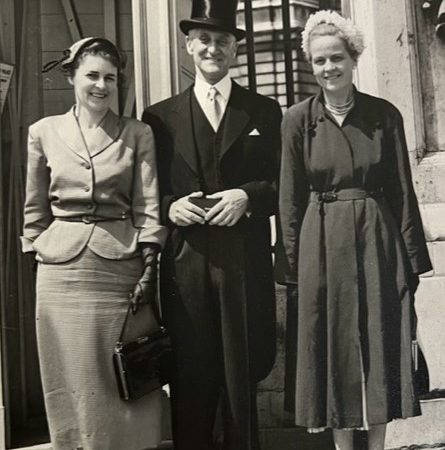
In March this year at the 100 Years of Tennis celebrations held at the National Arboretum, Leslie Frederick Charles (Les) Crawley MBE was formally inducted into the Tennis ACT Walk of Fame.
Les Crawley was born on 7 July 1891 in West Melbourne. He became an active and successful sportsman playing hockey, cricket and tennis. In 1912 Les joined the Customs Department and in 1916 he married Ivy Alice Olney. Les and Ivy had four children: Jean, Ron, Gwen and Alan, all born in Victoria. When Parliament and Departments moved to Canberra, Les, then aged 36, moved with his family to the new national capital in 1927/28.
Les immediately took up local sporting activities, notably cricket and tennis and he, Ivy and the family were foundation members of Reid Tennis Club, with Les elected as the club’s first Vice President in 1928.
Les also became actively involved in the Federal Capital Territory Lawn Tennis Association, serving as Club delegate and then in 1933 was elected Association Vice President. He was one of the early recipients of a Royal Blue and Gold Pocket Badge for ‘Meritorious service in the interests of tennis’.
With strong encouragement from Les and Ivy, the Crawley children made their mark on Canberra tennis, particularly Jean who married Charlie Boag, and Alan who married Norma Southwell. They and their prodigy have ensured the names of Crawley, Boag and Southwell have become enshrined in ACT tennis history.
In 1937 Les received a King George VI Coronation Medal for ‘Community contribution’. By now he had considerable standing in the Canberra sporting community and in the Public Service. Despite the impact of the Great Depression on Canberra, the 1930s had witnessed a boom in tennis with tennis now the number one local sport across males and females of all ages. Community clubs expanded and the Tennis Association was on a solid footing.
The outbreak of WW2 in the second half of 1939 brought an abrupt change. Les, in his role as Vice-President, then Acting-President, and from 1943 President, took the lead in managing the affairs of the Association through the darkest days of the war. These days included the resignation of the President prior to Les in 1942, the situation of only three clubs being able to pay their registration, and the Association being in dire financial straits. Manuka became unfit for play and was subject to vandalism. The Association took the step of writing to the Department of Interior offering to return the Manuka lease, but fortunately, the matter sat in abeyance until Les negotiated a 75 per cent reduction in club rentals and new lease agreements.
Following the end of the war in 1945, Les oversaw the recommencement of competitions, Resident Championships and the ACT Open, and the beginning of social activities and new coaching programs.
This resurgence occurred in a period when Les took on more senior roles in the Customs Department and at the same time, maintained a hands-on leadership role in the post-war recovery of the Tennis Association. Les continued to serve as President until early 1947 when he was posted overseas. On his return in 1948 he became the first Tennis Association Life Member. Sadly, in 1949 his wife Ivy died. Her devoted contribution to tennis over her lifetime was publicly acknowledged by the Association.
In 1951 Les became Patron of the Tennis Association. It was Les who, along with Bruce Mayo, made the first donations to a building fund to establish a new tennis headquarters in Canberra in 1951. Seventeen years later, Les held Foundation Membership No. 2 and Life Membership of the new National Tennis and Squash Centre at Lyneham.
In 1953 Les was awarded an MBE. In that same year he was awarded his second Coronation Medal, by Queen Elizabeth II, for ‘Community service, including tennis’.
Les Crawley, as philanthropist, administrator and family patriarch, left a lasting legacy on Canberra tennis and can rightly be considered a true father of Canberra tennis. Upon his death in 1990 at age 99, his obituary acknowledged a “distinguished Canberra citizen” and his citation at the 75th anniversary of Tennis ACT records his, “truly great service to ACT tennis.”

